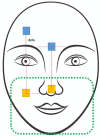Changes in skin characteristics after using respiratory protective equipment (medical masks and respirators) in the COVID-19 pandemic among healthcare workers
- PMID: 33813749
- PMCID: PMC8251455
- DOI: 10.1111/cod.13855
Changes in skin characteristics after using respiratory protective equipment (medical masks and respirators) in the COVID-19 pandemic among healthcare workers
Abstract
Background: The coronavirus disease-2019 (COVID-19) outbreak has presented unique dermatologic challenges due to respiratory protective equipment (RPE)-related skin conditions.
Objective: To objectively evaluate the effects of RPE including medical masks and respirators on the skin barrier by measuring various physiological properties of the skin.
Methods: A cross-sectional study was designed. Twenty healthy healthcare workers were included in this study. Skin parameters including skin hydration, transepidermal water loss (TEWL), erythema, sebum secretion, pH, and skin temperature were measured in the RPE-covered and RPE-uncovered areas of the face 4 and 8 hours after wearing RPE and 14 hours after not wearing RPE.
Results: Skin hydration, TEWL, erythema, pH, and skin temperature increased in the RPE-covered areas after wearing RPE for 4 and 8 hours. By contrast, in the RPE-uncovered areas, skin hydration decreased and TEWL, erythema, and pH showed minimal changes over time. Based on the repeated-measure analysis, the changes in skin physiological properties over time were significantly different between RPE-covered and RPE-uncovered areas.
Conclusion: We observed that skin physiological characteristics change with the prolonged use of RPE such as medical masks and respirators. These changes may lead to various adverse skin reactions after long-term use.
Keywords: COVID-19; adverse skin reaction; healthcare workers; medical mask; respirators; respiratory protective equipment; skin biophysical properties.
© 2021 John Wiley & Sons A/S . Published by John Wiley & Sons Ltd.
Conflict of interest statement
The authors have no conflict of interest to declare.
Figures



References
Grants and funding
LinkOut - more resources
Full Text Sources
Other Literature Sources

